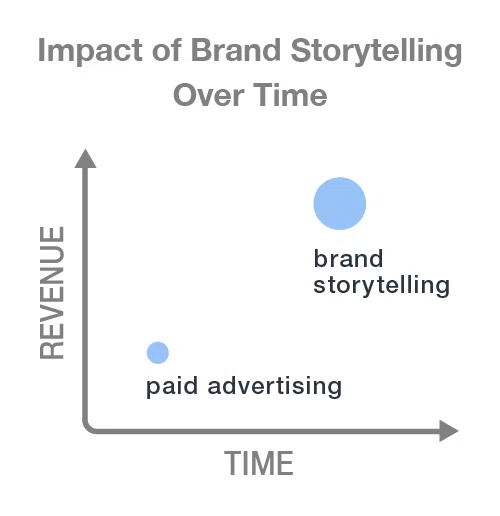
Want to publish great stories?
But you still have some questions on how to get these online?
Hop on the phone with one of our digital consultants and we will show you some examples and how they were made.
Readz brings together technology and expertise to help you create top-performing content marketing.

MADE WITH
READZ
TRY IT FREE
Storytelling In Marketing: Why It's Important & What Is The ROI?
Storytelling In Marketing: Why It's Important & What Is The ROI?
Welcome to this comprehensive how-to guide to storytelling in marketing. What is brand storytelling, what are the elements for success, what is the ROI and some real life examples and inspiration!
By Bart De Pelsmaeker

Storytelling in marketing is vital to the success of your brand because of the connection-building power it contains. Powerful connections = loyalty and trust, two things you cannot buy, but have everything to do with the livelihood of your brand and ROI.
Our guide to storytelling marketing is a comprehensive “how to” for telling your brand’s stories. From the “why’s” of its importance to the discovery of best strategies, our brand storytelling guide provides you with the tools to create an exciting experience for your audience.
What is brand storytelling?
If storytelling is the sharing of events through words and images for the purpose of education and entertainment, then brand storytelling is exactly that, as it relates to your brand.
Why is it important?
We are living in an age of go, go, go and bigger-better-faster, swimming against the ferocious tide in a sea of noisy, subpar content. Brand storytelling is the buoy that will keep your brand afloat while others slowly sink around you.
Don't you mean content marketing?
Don't you mean content marketing?
Just as every square is a rectangle but not every rectangle is a square, all brand storytelling is content marketing but not all content marketing is storytelling for marketing. Brand storytelling is a specific type of content marketing that draws us in emotionally.
Contents:
Good stories are memorable. We identify with them and the characters in them. Good stories affect us emotionally. They make us part of the story and so we can’t help but share with others. They make us believers, and many, brand advocates.
The question, then, is how does this advocacy influence the bottom line? Here are a few great examples demonstrating the ROI of brand storytelling.
Research from co:collective looked at the impact of brand storytelling on the financial performance of 42 publically traded companies.
They found brand storytelling to have a significantly greater impact on brand engagement than traditional advertising. This higher level of engagement lead to increased ROI. Here are a few highlights, as demonstrated by Type A Communications:
In 2011, when comparing the number of social media mentions for traditional branding/advertising messages vs storytelling, the latter approach garnered 1900 percent more mentionsOf those, storytelling prompted 10 percent more positive mentions
These companies spent almost two-thirds less on paid media per dollar of revenue
From 2008-2013, these companies experienced almost double the number of social media mentions compared with traditional branding/advertising approaches
Their annualized revenue growth rate from 2007-2011 was 70 percent higher.
And their annualized share price growth was 227 percent higher.
A study by co:collective
A study by co:collective
The Inspiring Case of BURBERRY
The Inspiring Case of BURBERRY
“Everything has a story — your clothes, buildings, videos, music. I think it’s important people go along with this journey otherwise it becomes a faceless product.”
He adds, “It’s all about touching people emotionally. . .language doesn’t matter — no matter where you are from, when you do something properly, people respond to that. It always surprises me how many people discover Burberry through our music projects for example. It’s important to keep innovating with your product and keep telling different stories with it.”(Sproutworth)
Burberry’s interactive brand storytelling
The surprising experiment revealing a 2700% price increase
The surprising experiment revealing a 2700% price increase
Significant Objects was an experiment demonstrating the objective measurability of brand storytelling on an object’s value.
The experiment was created by Rob Walker and Joshua Glenn as a literary and anthropological experiment to measure the subjective, objectively. Walker and Glenn bought items at garage sales, flea markets, etc., and took them back to their team of writers where they created compelling, impactful stories about each item and then re-sold them (with the added story) auction-style on sites like eBay.
The difference between the original purchase price and the resale (story) price is what served as the objective measurement on how stories affect ROI.
Pretty cool. And the results? Even better.
The average price for an original object in the experiment was $1.29. The average resale storytelling price was… (wait for it) … $36.12. That’s an increase of 2,700 percent! One of their most significant sales was a snow globe that was purchased for one dollar and later sold for $59.
Stories are such a powerful driver that their effect on any given [product's] subjective value can be measured objectively,”
- Joshua Glenn and Rob Walker
How TIFFANY & Co made 'love' their brand
How TIFFANY & Co made 'love' their brand
Tiffany & Co’s “What Makes Love True” campaign
How To Create Brand Stories With Amazing ROI
Give Distribution Power To Your Story
digital publishing platform
for example Readz
to create a stunning interactive asset. Then write the URLs down - as you would with any of our marketing assets - and keep them handy for easy sharing and educating about your brand.
Your brand story should touch all points of communication where your customers can learn more about your brand, from social media and marketing content to PR and events, so it’s critical that you are adequately prepared. That means verifying details and gathering information like dates, quotes, anecdotes, and names of key executives (writtent).
Here are some tips for sharing your brand story.
More Superb Business Storytelling Examples
Tell Stories #LikeAGirl
Tell Stories #LikeAGirl
The Always #LikeAGirl Campaign
How The Story Ends
The ROI Of Storytelling In Marketing
Great storytelling is an experience

Stories fascinate. Facts bore. Yes, facts are important, but stories make us care, and when we care, we respond.
We all have stories to tell. Select some.
We all have stories to tell. Select some.
Every brand has not just one, but multiple stories to tell. Every achievement, from the conception of your brand idea to the direction in which you are headed, contains stories. Here are just a few starting points:
What is the story of how your company started?
How does your brand impact people’s lives?
What is the story of your brand’s core values and beliefs?
What is the story behind your product?
Every brand has not just one, but multiple stories to tell. Every achievement, from the conception of your brand idea to the direction in which you are headed, contains stories. Here are just a few starting points:
What is the story of how your company started?- How does your brand impact people’s lives?
- What is the story of your brand’s core values and beliefs?
- What is the story behind your product?
How fast will you get results?
How fast will you get results?

The emotional Opel Tigra Story
The emotional Opel Tigra Story
Studies show that companies driven by a strong purpose, particularly a good brand story, grow their revenue four times faster, create seven times more jobs, and increase stock prices 12 times faster (Type A Communications).
Now that you have seen some real life examples, let’s talk about how you, too, can ensure a return on your brand storytelling. Here are some important considerations to make when building out your strategy:
This is not as obvious as it sounds, just bear with us. Robert Davis, Executive Director, Content Marketing & Advanced Video Practice at Ogilvy PR once said, “ROI must be built into the creation of your story” (The DMA)
While you can’t use a mathematical equation to create a good brand story, Davis reminds us that ROI should be considered from the very start. This means knowing where your story fits in the overall content marketing plan, defining your goals and objectives, knowing your KPIs and how you will measure success. Davis says:
"You need to know up front where a piece of content goes in the marketing/sales funnel (which can range from awareness to loyalty), what are you trying to say, where it’s going to run, and how you will measure it. Make sure every asset is created with a specific role in the funnel, and assign a KPI to every asset.”
"You need to know up front where a piece of content goes in the marketing/sales funnel (which can range from awareness to loyalty), what are you trying to say, where it’s going to run, and how you will measure it. Make sure every asset is created with a specific role in the funnel, and assign a KPI to every asset.”
The PLAN
The PLAN
While a high ROI can’t be guaranteed, it can be achieved through a carefully crafted and well thought out strategy.
This goes along with the previous point and is something that has always worked well for us. Strategizing can be a long and grueling process, but if you can figure out where you want to end up, then getting back to the start is like filling in missing pieces of the puzzle. Sometimes you have to imagine the bigger picture to make the small stuff really count.
Jay Baer, President of Convince & Convert, said,
Essentially, you should be turning your content creation process upside down. Worry less about what content you can create and which stories you can tell, and worry more about how you want to turn content consumption into leads, sales, and advocacy.”
Essentially, you should be turning your content creation process upside down. Worry less about what content you can create and which stories you can tell, and worry more about how you want to turn content consumption into leads, sales, and advocacy.”
Work backwards
Work backwards
A clear destination can actually inform your brand stories and lead to a much more focused point of view. Ask yourself, “What is the desired outcome?”
Leonardo Da Vinci was both a great artist and scientist, and if he were around today, he’d be a great storyteller, too. Approach your brand storytelling like Da Vinci. Allow the humanity and emotions to flow freely, but not so far away that you can’t reel it in, break it down, and measure the impact.
Numbers are important, but they are not what makes a good story, or else you’d just end up with a quota of words and images arranged with no regard to creativity, individuality, or emotion — the main driver of consumer decisions.
We are all fixated on numbers, but it’s human-to-human connections that are the heart of marketing. Brand storytelling is a technique that can reinforce those connections (Quicksprout).
Use your head and your heart, Da Vinci style
Use your head and your heart, Da Vinci style
Your brand stories don’t always have to be about you; in fact, the majority of them shouldn’t be. Brands have many stories and the most powerful ones are often customer success stories. Over time, these stories build a solid foundation of trust around your brand.
Ekaterina Walter, bestselling author and Co-founder/CMO of Branderati, affirms, “Advocacy, done right, becomes true influence. And influence is what impacts behaviors. Because the ultimate goal of marketing is to not just to tell a great story, but to tell a story that would make people want to get to know a brand and buy the product.” (MackCollier)
Build advocacy through human success stories
Build advocacy through human success stories
People love to talk about themselves, so don't be afraid to get personal with your audience (to an extent of course -- don't be intrusive). Not only will people share their stories and experiences with you, but they will love that you care.
According to Bazaarvoice, 64 percent of millennials and 53 percent of baby boomers want more options to share their opinions about brands, while other studies show that consumers trust UGC (user generated content) more than all other forms of media (HubSpot).
Get creative with your approach and consider a UGC campaign.
Engage through curiosity
Engage through curiosity
One of our favorite examples is Starbucks' White Cup contest, which prompted 4,000 customers to submit entries over the course of three weeks (that's alotta coffee).
Can brand storytelling deliver a high ROI? Yes, it can — through thoughtful strategy that factors in ROI from the start. Use your head and your heart, and allow the relationship between your brand’s goals and your user’s desires flourish.
Returns can be slow, but don’t let that discourage you. Remember: Rome wasn’t built in a day — neither are great brands.
Conclusion
Conclusion
Even the best brand stories need matched delivery. This includes voice, tone, wording, language, style, and imagery among other things. Good storytelling captures attention, draws people in, keeps them engaged, and builds a bond between listener and teller.
Show your story; don’t just tell it. Learn how to set the stage, create a mood, appeal to the senses, and use a hook ending that keeps the listeners wanting more (Amanda Lewan).
Match the delivery to your story
Match the delivery to your story
Make sure that your employees are invested in the story and carry it with them both online and off. Employees are perhaps your biggest brand advocates and are crucial to communicating with customers.
Consider them a mouthpiece for sharing your story, but more than that, they should understand why the story is so important and how it will help the success of your brand (small business pr). This education is key to consistency and, ultimately, the virality of your brand story.
Empower your employees and customers
Empower your employees and customers
It's important to remember that your customers are not just transactions but real, living, breathing human beings who crave connectivity with others (note: other humans, not corporations). So show your humanity! But first, do your research.
Find out which platforms your customers like to hang out on and how they engage. More than just research, actually talk to them. Find out their favorite networks, the brands they're following, who they're interacting with and what manner. Why are they on social media in the first place? What do they value most from the brands they follow?
CEO/Founder of TheBuzzPlant, Bob Hutchins, says that everyone in your target audience has, “a desire to share and connect. But where they go for this end can vary greatly. Do your research!”Just as companies continue to grow, so do stories. Continue to add relevant and up-to-date anecdotes for context, and “freshness.”
Research Where Your Audience Is
Research Where Your Audience Is
The thing about stories is that they keep on going and keep on telling. Best of all, they continue to connect with listeners. Only this can't happen if you get so stuck in your story that you never go back to it. Neil Patel writes:
Keep on telling the story
Keep on telling the story
A story is the framework for a business’s life. The story shouldn’t create a trap, but serve as a catalyst. Some brands get so caught up in their story, that they neglect the value of their present activation."
A story is the framework for a business’s life. The story shouldn’t create a trap, but serve as a catalyst. Some brands get so caught up in their story, that they neglect the value of their present activation."
Just as companies continue to grow, so do stories. Continue to add relevant and up-to-date anecdotes for context, and “freshness.”
User-Generated Content With GoPro
Captivating 'History' Content With General Electric
< BACK TO OVERVIEW
Create Content Experiences.
Better. Faster.
STAY IN THE KNOW
Sign up for our newsletter
Actionable advice on how to create better content & design, product updates and occasional other news. All delivered to your inbox.